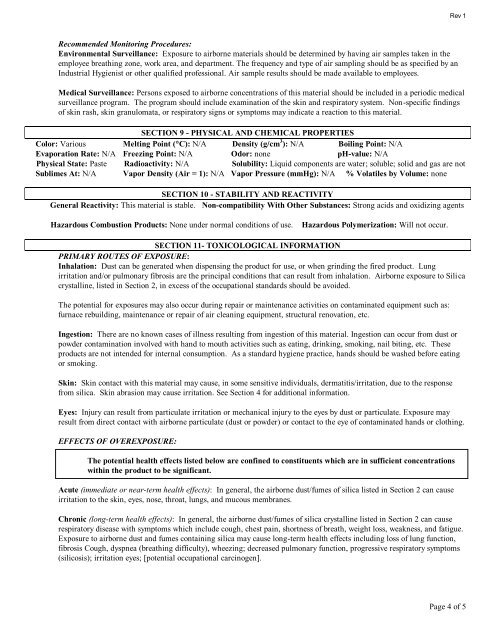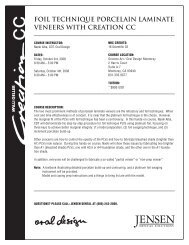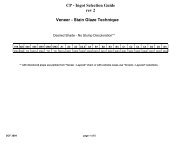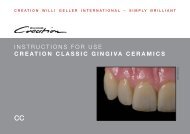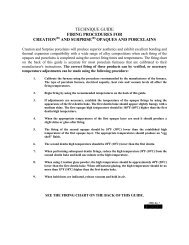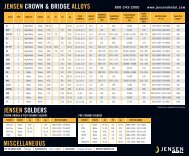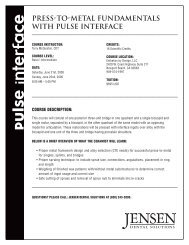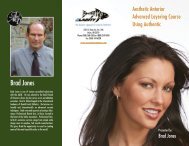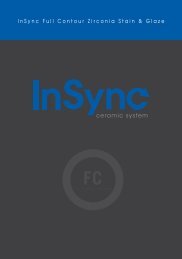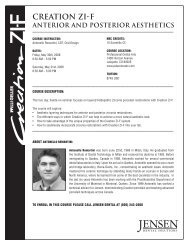Creapast MSDS - Jensen Dental
Creapast MSDS - Jensen Dental
Creapast MSDS - Jensen Dental
- No tags were found...
Create successful ePaper yourself
Turn your PDF publications into a flip-book with our unique Google optimized e-Paper software.
Rev 1Recommended Monitoring Procedures:Environmental Surveillance: Exposure to airborne materials should be determined by having air samples taken in theemployee breathing zone, work area, and department. The frequency and type of air sampling should be as specified by anIndustrial Hygienist or other qualified professional. Air sample results should be made available to employees.Medical Surveillance: Persons exposed to airborne concentrations of this material should be included in a periodic medicalsurveillance program. The program should include examination of the skin and respiratory system. Non-specific findingsof skin rash, skin granulomata, or respiratory signs or symptoms may indicate a reaction to this material.SECTION 9 - PHYSICAL AND CHEMICAL PROPERTIESColor: Various Melting Point ( C): N/A Density (g/cm 3 ): N/A Boiling Point: N/AEvaporation Rate: N/A Freezing Point: N/A Odor: none pH-value: N/APhysical State: Paste Radioactivity: N/A Solubility: Liquid components are water; soluble; solid and gas are notSublimes At: N/A Vapor Density (Air = 1): N/A Vapor Pressure (mmHg): N/A % Volatiles by Volume: noneSECTION 10 - STABILITY AND REACTIVITYGeneral Reactivity: This material is stable. Non-compatibility With Other Substances: Strong acids and oxidizing agentsHazardous Combustion Products: None under normal conditions of use.Hazardous Polymerization: Will not occur.SECTION 11- TOXICOLOGICAL INFORMATIONPRIMARY ROUTES OF EXPOSURE:Inhalation: Dust can be generated when dispensing the product for use, or when grinding the fired product. Lungirritation and/or pulmonary fibrosis are the principal conditions that can result from inhalation. Airborne exposure to Silicacrystalline, listed in Section 2, in excess of the occupational standards should be avoided.The potential for exposures may also occur during repair or maintenance activities on contaminated equipment such as:furnace rebuilding, maintenance or repair of air cleaning equipment, structural renovation, etc.Ingestion: There are no known cases of illness resulting from ingestion of this material. Ingestion can occur from dust orpowder contamination involved with hand to mouth activities such as eating, drinking, smoking, nail biting, etc. Theseproducts are not intended for internal consumption. As a standard hygiene practice, hands should be washed before eatingor smoking.Skin: Skin contact with this material may cause, in some sensitive individuals, dermatitis/irritation, due to the responsefrom silica. Skin abrasion may cause irritation. See Section 4 for additional information.Eyes: Injury can result from particulate irritation or mechanical injury to the eyes by dust or particulate. Exposure mayresult from direct contact with airborne particulate (dust or powder) or contact to the eye of contaminated hands or clothing.EFFECTS OF OVEREXPOSURE:The potential health effects listed below are confined to constituents which are in sufficient concentrationswithin the product to be significant.Acute (immediate or near-term health effects): In general, the airborne dust/fumes of silica listed in Section 2 can causeirritation to the skin, eyes, nose, throat, lungs, and mucous membranes.Chronic (long-term health effects): In general, the airborne dust/fumes of silica crystalline listed in Section 2 can causerespiratory disease with symptoms which include cough, chest pain, shortness of breath, weight loss, weakness, and fatigue.Exposure to airborne dust and fumes containing silica may cause long-term health effects including loss of lung function,fibrosis Cough, dyspnea (breathing difficulty), wheezing; decreased pulmonary function, progressive respiratory symptoms(silicosis); irritation eyes; [potential occupational carcinogen].Page 4 of 5


